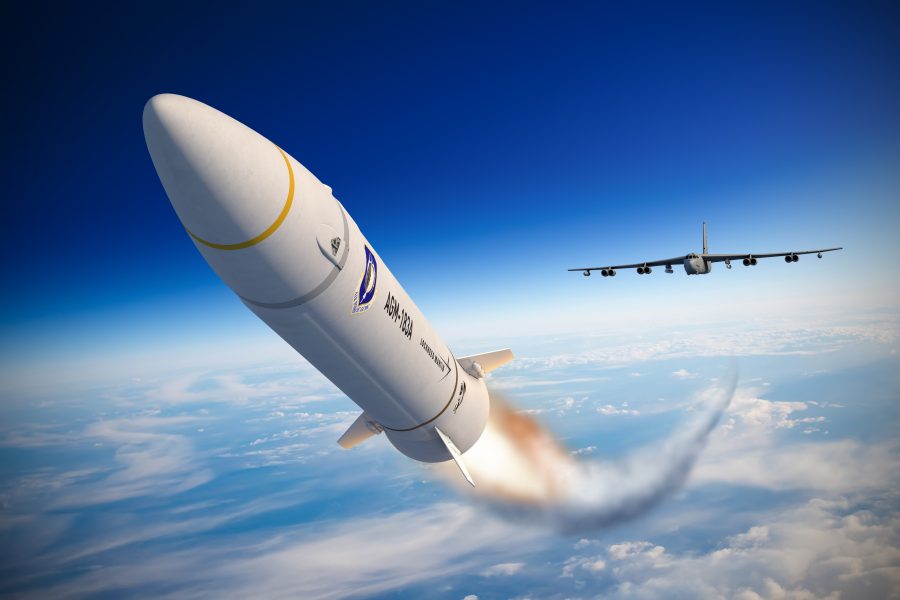The Air Force picked the AGM-183 Air-launched Rapid Response Weapon hypersonic missile over the Hypersonic Conventional Strike Weapon because it’s more advanced and is a better match to the Air Force’s needs, and the HCSW just didn’t fit in an overcrowded budget, service acquisition chief Will Roper reported Feb. 28.
“The reason we went with ARRW was not that HCSW was bad, but ARRW is smaller; we can carry twice as many on the B-52, and it’s possible it could be on the F-15 … It’s in the class to be able to fit on the centerline” station, Roper told reporters at AFA’s Air Warfare Symposium in Orlando, Fla. Though he didn’t elaborate on this point, the F-15 could accelerate the ARRW to Mach 3 before launch, potentially reducing the size of the booster needed to get the weapon to hypersonic speed.
He also called ARRW a “unique design” and “more advanced”
than HCSW. The ARRW program passed its Critical Design Review last week.

Both weapons are boost-glide systems, in which a rocket propels the weapon to hypersonic speed, and it then glides and maneuvers to its target. ARRW is based on the Defense Advanced Research Projects Agency Tactical Boost Glide (TBG) project.
“I truly, truly hated to downselect between HCSW and ARRW a year early,” Roper said. The HCSW team was “doing everything right at the program level” and would have progressed to flight testing within a year. But “with all the … huge initiatives” on the Air Force’s budgetary plate in fiscal 2021—big-ticket items ranging from Joint All-Domain Command and Control, the Advanced Battle Management System that “powers it,” nuclear modernization, space superiority, and the standup of Space Force—the service “had to make tough choices, and one of them was downselecting early,” Roper explained.
The service had previously said the money not used on HCSW would be redirected to the ARRW, and an Air Force spokesman told Air Force Magazine on Feb. 28 the funds left over amount to about $200 million. The service declined to say specifically what it had spent on HCSW, but the development contract was worth up to $928 million.
Lockheed Martin was the prime contractor for both systems; its Missiles and Fire Control unit is developing ARRW, while the Space division was developing HCSW. Surface-launched versions of HCSW will still be pursued by the Army and Navy.
While both programs were progressing well, Roper said, picking ARRW early lets the Air Force start gearing up the industrial base to build the weapon in quantity.
“On both programs, we have single suppliers. We would like to get to dual suppliers, for both, so that we don’t just succeed in flight testing, we move into an industry base that’s capable of building at scale,” Roper said. “And the kind of scale we’re looking at is not at the mass production level, … but we’d like a very adaptable, agile industry base that can allow us to do spiral upgrades, lot to lot.”
Among the suppliers will be those who can “print 3-D components like leading edges, that we think we’ll need to iterate on, so that we’ve got an adaptable, agile industry base, where we don’t have single points of failure,” Roper noted.
By picking ARRW sooner than planned, “we’re able to start bringing on second suppliers a year earlier than we would have,” Roper said.
The Air Force’s HCSW would have used the same gliding body to be used by the Army and Navy for their hypersonic programs; the Land-Based Hypersonic Missile and the Intermediate Range Conventional Prompt Strike Weapon, respectively.
Asked if there can still be cooperation with the other services now that they are no longer using a common vehicle, Roper said, “We will certainly stay synched with them, on just the state of hypersonics in general.” HCSW will continue through the completion of its Critical Design Review this month to capture all the knowledge generated by the effort, he add. Roper also cryptically said completing the CDR will help if the HCSW needs to be “started again in the future.”
The Air Force’s HCSW termination action, at the Department of Defense “portfolio level … diversifies the number of flight bodies that are being looked at,” Roper observed. “We’re not all looking at the same thing. So, we had multiple reasons to select ARRW, but none of them being that HCSW was bad.”


